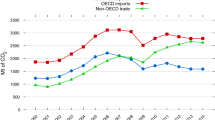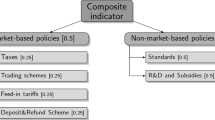Abstract
This paper examines the implications of restricting the tradability of carbon rights in the presence of induced technological change. Unlike earlier approaches aimed at exploring the tradability-technology linkage, we focus on climate-relevant “carbon-saving” technological change. This is achieved by incorporating endogenous investment in carbon productivity into the RICE-99 integrated assessment model of Nordhaus and Boyer (2000). Simulation analysis of various emission reduction scenarios with several restrictions on emissions trading reveals a pronounced dichotomy of effects across regions: Restrictions to trading raise the investments in carbon productivity in permit demanding regions while reducing them in permit supplying regions. In terms of per capita consumption, permit demanding regions lose and permit supplying regions gain from restrictions. In scenarios that involve “hot air,” restrictions to trade lower overall emissions, which results in reduced climate damage for most regions. Reduced damage, in turn, reduces the incentive to invest in carbon productivity.
Similar content being viewed by others
References
P. Aghion P. W. Howitt (1998) Endogenous Growth Theory MIT Press Cambridge
Böhringer, C. and H. Welsch (2005), ‘Burden Sharing in a Greenhouse: Egalitarianism and Sovereignty Reconciled’, Applied Economics, forthcoming
Brooke, A., D. Kendrick, A. Meeraus and R. Raman 1998, GAMS: A User’s Guide, http://www.gams.com/docs/gams/GAMSusersguide.pdf
P. Buonanno C. Carraro E. Castelnuovo M. Galeotti (2001) ArticleTitle‘Emission Trading Restrictions with Endogenous Technological Change’ International Environmental Agreements 1 379–395 Occurrence Handle10.1023/A:1011594622427
P. Buonanno C. Carraro M. Galeotti (2003) ArticleTitle‘Endogenous induced technological change and the costs of Kyoto’ Resource and Energy Economics 25 11–34 Occurrence Handle10.1016/S0928-7655(02)00015-5
D. T. Coe E. Helpman (1995) ArticleTitle‘International R&D Spillovers’ European Economic Review 39 859–887 Occurrence Handle10.1016/0014-2921(94)00100-E
Drud, A. (1996), CONOPT, http://www.gams.com/solvers/conopt.pdf
A. D. Ellerman (2005) ArticleTitle‘A Note on Tradeable Permits’ Environmental and Resource Economics 31 123–131 Occurrence Handle10.1007/s10640-005-1760-z
D. Frantzen (2000) ArticleTitle‘R&D, Human Capital and International Technology Spillovers: A Cross-country Analysis’ Scandinavian Journal of Economics 102 57–75 Occurrence Handle10.1111/1467-9442.00184
R. Golombek M. Hoel (2005) ArticleTitle‘Climate Policy under Technology Spillovers’ Environmental and Resource Economics 31 201–227 Occurrence Handle10.1007/s10640-005-1771-9
L. H. Goulder K. Mathai (2000) ArticleTitle‘Optimal CO2 Abatement in the Presence of Induced Technological Change’ Journal of Environmental Economics and Management 39 1–38 Occurrence Handle10.1006/jeem.1999.1089
M. Grubb D. Brack C. Vrolijk (1999) The Kyoto Protocol: A Guide and Assessment The Royal Institute of International Affairs London
Grubb, M., J.-C. Hourcade and S. Oberthür (2001), Keeping Kyoto, Climate Strategies, http://www.climate-strategies.org/; viewed 3 August 2001
Hourcade, J. C. and T. Le Pesant (2000), ‘Negotiating Targets, Negotiating Flex-Mex: The Economic Background of a US-EU Controversy’, in C. Carraro, ed., Efficiency and Equity of Climate Change Policy, (pp. 63–90). Dordrecht: Kluwer Academic Publishers
IPCC (2001) in R. T. Watson and the Core Writing Team, eds., Climate Change 2001: Synthesis Report. A Contribution of Working Groups I, II and III to the Third Assessment Report of the Intergovernmental Panel on Climate Change, Cambridge University Press, Cambridge, United Kingdom, and New York, NY, USA, 398 pp.
Jaffe, A. B., R. G. Newell and R. N. Stavins (2000), ‘Technological Change and the Environment’, Resources for the Future, Discussion Paper 00–47
M. Liski J. -P. Montero (2005) ArticleTitle‘A Note on Market Power in an Emission Permits Market with Banking’ Environmental and Resource Economics 31 159–173 Occurrence Handle10.1007/s10640-005-1769-3
A. Löschel (2002) ArticleTitle‘Technological Change in Economic Models of Environmental Policy: A Survey’ Ecological Economics 43 IssueID2–3 105–126
R. Newell W. Pizer J. Zhang (2005) ArticleTitle‘Managing Permit Markets to Stabilize Prices’ Environmental and Resource Economics 31 133–157 Occurrence Handle10.1007/s10640-005-1761-y
W. D. Nordhaus (1994) Managing the Global Commons: The Economics of Climate Change MIT Press Cambridge, MA
W. D. Nordhaus J. Boyer (2000) Warming the World: Economic Models of Global Warming MIT Press Cambridge, MA
W. D. Nordhaus Z. Yang (1996) ArticleTitle‘A Regional Dynamic General-Equilibrium Model of Alternative Climate-Change Strategies’ American Economic Review 86 IssueID4 741–765
S. Oberthür H. E. Ott (1999) The Kyoto Protocol Springer Berlin, Heidelberg, New York
OECD (1987–1998), Main Science and Technology Indicators. Organization For Economic Co-Operation And Development, Paris
InstitutionalAuthorNameOECD/IEA (1997) IEA Energy Technology R&D Statistics 1974–1995 International Energy Agency Paris
D. Popp (2004) ArticleTitle‘ENTICE: Endogenous Technological Change in the DICE Model of Global Warming’ Journal of Environmental Economics and Management 48 742–768 Occurrence Handle10.1016/j.jeem.2003.09.002
T. Requate (2005) ArticleTitle‘Timing and Commitment of Environmental Policy, Adoption of New Technology, and Repercussions on R&D’ Environmental and Resource Economics 31 175–199 Occurrence Handle10.1007/s10640-005-1770-x
P. Stoneman (Eds) (1983) The Economics of Technological Change Oxford University Press Oxford, UK
Weyant, J. P. and J. N. Hill (1999), ‘Introduction and Overview, The Cost of the Kyoto Protocol: A Multi-Model Evaluation’, The Energy Journal, Kyoto Special Issue
J. P. Weyant T. Olavson (1999) ArticleTitle‘Issues in modeling induced technological change in energy, environmental, and climate policy’ Environmental Modeling and Assessment 4 67–85 Occurrence Handle10.1023/A:1019012317160
E. Woerdman (2002) ‘Why did the EU Propose to Limit Emissions Trading? A Theoretical and Empirical Analysis’ J. Albrecht (Eds) Instruments for Climate Policy Edward Elgar Cheltenham, Northampton
Author information
Authors and Affiliations
Corresponding author
Rights and permissions
About this article
Cite this article
Matschoss, P., Welsch, H. International Emissions Trading and Induced Carbon-Saving Technological Change: Effects of Restricting the Trade in Carbon Rights. Environ Resource Econ 33, 169–198 (2006). https://doi.org/10.1007/s10640-005-3105-3
Accepted:
Issue Date:
DOI: https://doi.org/10.1007/s10640-005-3105-3
Keywords
- carbon-saving technological progress
- emissions trading
- flexibility mechanism
- induced technological change
- integrated assessment model




